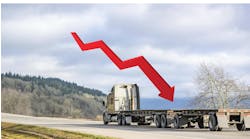Total U.S. business spending on logistics rose 6.2% in 2017 from the previous year to $1.5 trillion, according to the annual State of Logistics Report issued by the Supply Chain Management Professionals (CSCMP).
That figure was 7.7% of U.S. gross domestic product in 2017. Costs rose for a number of reasons, including tighter capacity, higher fuel prices rise, and a growing shortage of truck drivers.
"The demand-supply balance shifted much more dramatically this year when compared to last year," said Sean Monahan, A.T. Kearney partner and report co-author. "In 2015 it was a dark story if you were a carrier. There was a lot of excess capacity in the marketplace. We saw that starting to turn around in 2016 and continued to accelerate into 2017."
Logistics costs actually dipped in 2016 for the first time in 2009, but were higher across the board in 2017, including a 9.5% spike dedicated trucking costs. Less-than-truckload freight, where costs have dropped steadily in recent years, saw a 6.6% rise, while parcel and express deliveries — a segment closely tied to e-commerce — saw a 7% jump in costs.
E-commerce growth is leading to a greater need for supply chain visibility and more warehousing space closer to large population areas.
“Before long, infrastructure costs may become a drag on e-commerce growth, and a potential advantage for brick-and-mortar retailers whose stores can double as delivery nodes,” the report said.
Looking ahead, the report said to expect robust macroeconomic growth, but also higher logistics costs due to rising interest rates, a tighter labor market, and higher fuel prices.
The report also said strong demand and new competitors to the marketplace will challenge old business models.
“The next-generation supply chain will improve fulfillment and drive efficiency through technologies such as big data and predictive analytics, artificial intelligence, robotics, crowdsourcing, and electric and autonomous vehicles,” the report said.



